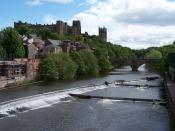Standing on a cliff overlooking the River Wear in England, Durham Cathedral began construction in 1093 A.D. and was finally completed in 1133. It was intentionally built just to the south of Durham Castle, so that the two buildings together would present a formidable defensive position against attacks from the north. Because of the constant threat of violence, the architect who designed it was slow to incorporate the light and airy Gothic style present in cathedral design throughout the rest of England. Thick carved pillars dominate the nave of Durham Cathedral, and the relatively few small windows leave the interior dominated by a damp gloom more characteristic of a castle than a church. The carved stone vaulting of the aisles and nave give an idea more of sheer strength rather than ornamental delicateness. It is not clear how much the building was meant to glorify God and how much to stand up to the persistent Scottish invaders, since at the time of the cathedral's construction, the city of Durham stood as the one of the most important northern outposts for the Normans, so it was targeted for incursion quite frequently.
The Cathedral is now considered by many to be the foremost example of late-Norman cathedral architecture.
The Saint who is buried in Durham Cathedral made it one of the greatest centers of pilgrimage throughout the middle ages, because of his extravagantly decorated shrine. "The entire immediate area around St. Cuthbert's tomb was once adorned with green marble and gold gilding, along with other jewels and relics associated with the Saint. However, during the Reformation in 1540, the shrine was dismantled and the relics buried on the spot where it had stood." (Schutz). Bishop Thomas Hatfield was also entombed in the Cathedral, and contributed to its renown. His burial place...


